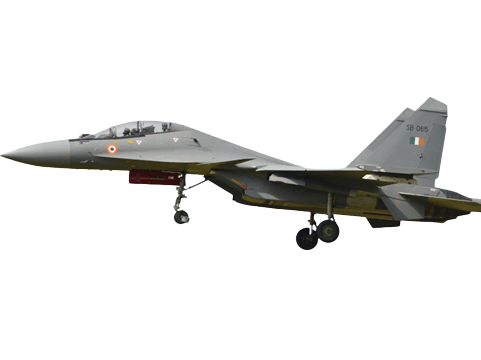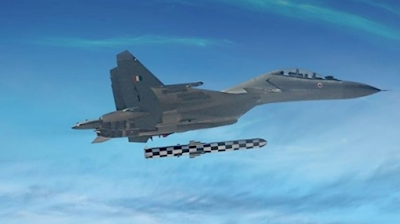The Fearless Falcon: Tracing the Legacy of Sukhoi Su-30 MKI
Image 1 IAFs Su-30 MKI
The Russian designed
Sukhoi Su-30 MKI and produced in collaboration with India’s Hindustan
Aeronautics Limited, represents a synergy of engineering brilliance and
tactical excellence. It stands as a testament to the collaborative efforts of
two nations, resulting in a fighter aircraft that has established its dominance
in the skies.
In this blog, we will
delve into the various aspects that make the Su-30 MKI a true force to be
reckoned with.
History:
The Su-30MKI was designed by Russia's
Sukhoi Corporation beginning in 1995 and built under licence by India's Hindustan
Aeronautics Limited (HAL).
The Su-30MKI is derived from the Sukhoi
Su-27 and has a fusion of technology from the Su-37 demonstrator and
Su-30 program, being more advanced than the baseline Su-30. The avionics
were developed by Russia, the display navigation and electronic warfare by
Israel and India. The first prototype, Su-30I-1, made its first flight in July
1997. Production began at the Irkutsk plant in 2000. The first pre-production
aircraft completed its maiden flight in November 2000.
After two years of evaluation and
negotiations, on 30 November 1996, India signed a US$1.462 billion deal
with Sukhoi for 50 Russian-produced Su-30MKIs in five batches. In December
2000, a deal was signed at Russia’s Irkutsk aircraft plant for a full
technology transfer. The Indian Air Force (IAF) has ordered 272 aircraft, of which 50
were to be delivered by Russia in 2002-2004 and 2007. The rest of 222 planes
are to be produced under license at HAL's Indian facilities in 2004. In total,
India has 272 Su-30 MKIs.
DESIGN CHARATERISTICS
Airframe and Bodywork
The twinjet multirole air superiority
fighter is constructed of titanium and aluminium alloys. The twin stabilisers
and horizontal tail consoles are joined to tail beams. The semi-monocoque
fuselage head includes the cockpit, radar sections and the avionics bay. The
section between the engine nacelles houses the equipment bay, fuel storage and
the brake parachute mechanism. The aircraft has a length of 21.9m, wingspan of
14.7m and a height of 6.4m. The maximum take-off weight of Su-30MKI is
38,800kg.
COCKPIT
Image 2Cockpit of a upgraded Su-30 MKI
The cockpit accommodates two pilots. The
forward cockpit display includes a customised version of Israeli Elbit So 967
HUD, and seven multifunction Liquid-Crystal Displays, six 127 mm ×
127 mm and one 152 mm × 152 mm. The rear cockpit has a large
monochrome display for air-to-surface missile guidance.
The Su-30MKI on-board health and usage
monitoring system (HUMS) monitors almost every aircraft system and sub-system,
and can also act as an engineering data recorder. From 2010, indigenously
designed and built HUDs and Multi-Function Displays (MFD) were produced by the
Delhi-based Samtel Group Display Systems.
AVIONICS
Image 4: N011M Bars Radar System.
Laser Optical Locator.
The Su-30MKI is also equipped with a N011M passive
electronically scanned array radar, OLS-30 laser-optical locator system and
Litening target designation pod to guide air-to-surface missile and laser
guided munitions.
The N011M Bars radar system provides
long-range detection and tracking of targets, along with advanced air-to-air
and air-to-surface modes. The aircraft also features an advanced electronic
warfare suite, which includes radar warning receivers, electronic
countermeasures, and a chaff/flare dispensing system, enhancing its
survivability in hostile environments. Additionally, the Su-30 MKI is equipped
with a digital fly-by-wire flight control system, allowing for precise manoeuvrability
and enhanced stability. The integration of these cutting-edge avionics ensures
that the Su-30 MKI remains a formidable force in both air-to-air and
air-to-ground missions, making it a vital asset in modern aerial warfare.
PROPULSION
The aircraft is powered powered by two
Lyulka-Saturn AL31FP turbofans, each rated at 12,500 kgf of full
after-burning thrust, which enable speeds of up to Mach 2 in horizontal flight
and a rate of climb of 230 m/s. The aircraft has a maximum unrefuelled
flight range of 3,000km. The in-flight refuelling system of Su-30MKI provides a
maximum range of 8,000km with two refuellings.
WEAPONS
The Su-30MKI is armed with a 30mm Gsh-30-1 cannon with 150 rounds of ammunition. The aircraft features 12 hardpoints capable of carrying external stores of up to 8t. The aircraft can launch a range of air-to-surface missiles, including Kh-29L/T/TYe, Kh-31A/P, Kh-59M and Nirbhay.
The Su-30MKI fleet of IAF was fitted with air-launched version
of BrahMos supersonic cruise missiles and was successfully tested in November
2017. The BrahMos can strike targets within the range of 290km. The IAF
completed the successful integration of the cruise missile on the fighter, with
the third live firing of the missile from the aircraft in December 2019.
S-30 MKI dropping a Brahmos missile
The aircraft can also carry Vympel-built R-27R, R-73 and R-77 air-to-air missiles, as well as rocket pods, KAB-500 and KAB-1500 laser-guided bombs.The Su-30MKI is fitted with a Tarang radar
warning receiver (RWR) indigenously developed by the Defence Research and
Development Organisation (DRDO). The aircraft also integrates chaff / flare
dispensers and active jammers.
INDIAN AIR
FORCE
The Sukhoi Su-30MKI is the most potent
fighter jet in service with the Indian Air Force in the late 2000s. The MKIs are often
fielded by the IAF in bilateral and multilateral air exercises. On 26
February 2019, four Sukhoi Su-30MKIs escorted Mirage 2000s into the Pakistani
airspace for the Balakot Airstrike on an alleged Jaish-e-Mohammad camp. The
following day, two Su-30MKIs on combat air patrol were reportedly
attacked by multiple Pakistani F-16s using AMRAAM missiles. The missiles
were successfully dodged according to India.
On 8 October 2019, during the Indian Air
Force Day celebrations, the IAF reportedly flew the Su-30MKI that Pakistan
claimed to have shot down.
The achievements of the Su-30 MKI in the Indian Air Force include maintaining
air superiority, conducting precision strikes on ground targets, extending
operational reach, participating in joint exercises, and aiding in humanitarian
assistance and disaster relief operations. These accomplishments highlight the
aircraft's versatility, operational effectiveness, and its significant
contributions to the Indian Air Force's mission success.
In conclusion, the Su-30
MKI stands as a testament to the advancements in modern fighter aircraft
technology. With its impressive avionics, including the state-of-the-art radar
system and electronic warfare suite, coupled with its extensive arsenal of weapons,
the Su-30 MKI demonstrates unparalleled combat capabilities. Whether engaging
in air-to-air combat or striking ground targets, this aircraft offers
exceptional manoeuvrability, precision, and versatility. The Su-30 MKI
continues to serve as a formidable asset in the Indian Air Force, embodying the
pinnacle of aeronautical engineering and playing a crucial role in safeguarding
national security.










Comments
Post a Comment